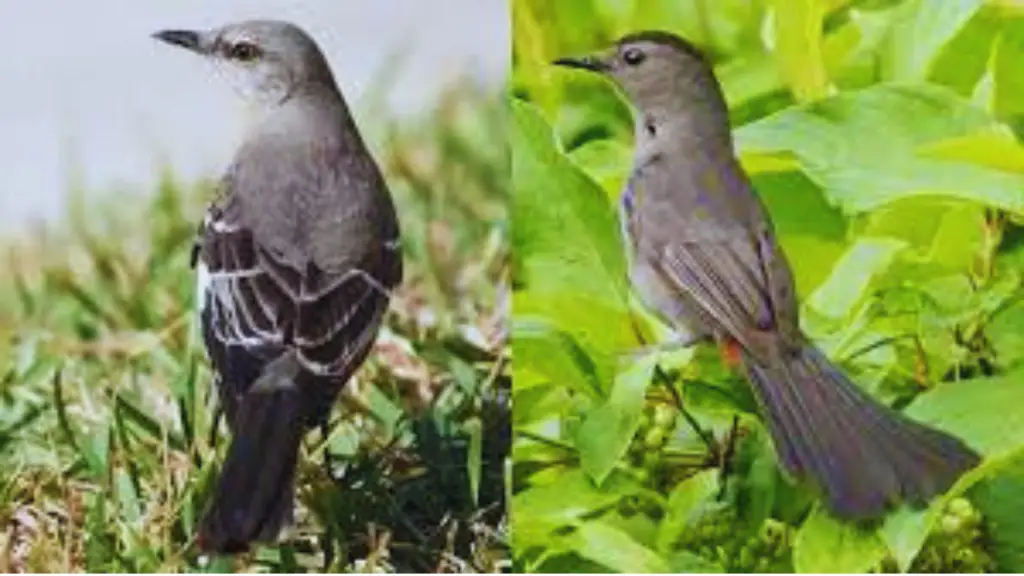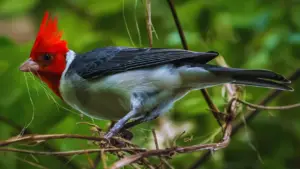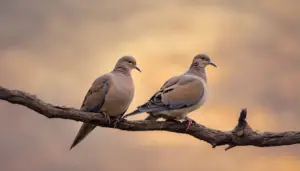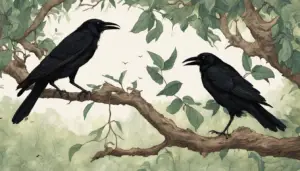Exploring Mockingbird vs Catbird: What Sets Them Apart?: Delve into the world of Mockingbirds and Catbirds and uncover their individual characteristics. Learn about their physical attributes, feeding habits, nesting behaviors, and song variations, allowing you to distinguish between these two remarkable birds.
Have you ever found yourself captivated by the enchanting melodies of birds? Imagine this: you’re walking through a tranquil park, the sun gently kissing your skin, when suddenly two distinct tunes fill the air. One is a complex symphony, a medley of various bird calls woven together seamlessly. The other is a melodious solo, rich and resonant. You stop in your tracks, drawn to the mesmerizing sounds, and wonder: What birds are responsible for these unique tunes?
So, grab your binoculars and get ready to embark on a melodic duel between the mockingbird and the catbird.
Key Takeaways
- Mockingbirds and catbirds are skilled at using their vocal abilities to create a symphony of sounds and convey messages.
- Mockingbirds have exceptional mimicry skills, imitating the songs of over 50 different bird species and even human-made noises.
- Catbirds have a melodious and flute-like song, with a wide range of notes, trills, and whistles.
- Mockingbirds prefer urban and suburban areas, while catbirds thrive in woodlands and thickets.
Introduction to the World of Birdsong
Get ready to immerse yourself in the enchanting world of birdsong, where you’ll discover the mesmerizing melodies of mockingbirds and catbirds! These two songsters are renowned for their unique tunes that fill the air with a symphony of sounds.
As you delve into this fascinating topic, you’ll be captivated by the beauty and complexity of bird songs.
Birdsong is a form of communication that plays a vital role in the lives of birds. It serves various purposes, such as attracting mates, defending territories, and establishing social hierarchies. Mockingbirds and catbirds are particularly adept at using their voices to convey messages and create intricate melodies.
Mockingbirds, known for their exceptional mimicry skills, have the ability to imitate the sounds of other birds, as well as other animals and even human-made noises. Their repertoire is vast and ever-evolving, making them one of nature’s finest performers.
Catbirds, on the other hand, have a more melodious and flute-like song that is both enchanting and soothing to the ear.
Listening to the songs of mockingbirds and catbirds is like entering a magical world where nature’s music takes center stage. So, get ready to be serenaded by these feathered virtuosos as we embark on a journey exploring the captivating melodies of mockingbirds and catbirds.
The Melodious Tunes of the Mockingbird
When it comes to mimicking other bird species, the mockingbird is a true master. With its complex and varied repertoire, it can imitate the songs of countless other birds, from robins to cardinals to blue jays.
And what’s even more impressive is that the mockingbird doesn’t limit its singing to daytime hours – it can be heard serenading the night away as well.
So if you ever find yourself in the presence of a mockingbird, be prepared to be amazed by its impressive vocal abilities.
Mimicking Other Bird Species
Out of all the incredible talents possessed by mockingbirds and catbirds, one of the most fascinating is their ability to mimic the songs of other bird species. These talented songsters have mastered the art of imitating various bird calls, fooling even the most experienced birdwatchers.
Here are three examples of their enchanting mimicry:
- The hauntingly beautiful song of the wood thrush: As the sun sets and darkness falls, the catbird’s melodious tune transforms into the ethereal melody of the wood thrush, filling the night air with its enchanting notes.
- The cheerful chirping of the American robin: With a quick shift in pitch and rhythm, the mockingbird seamlessly transitions from its own song to mimic the familiar call of the American robin, bringing a touch of springtime to any setting.
- The piercing cry of the red-tailed hawk: Watch in awe as the mockingbird or catbird flawlessly imitates the commanding screech of the red-tailed hawk, sending a ripple of excitement through the surrounding avian community.
With their unparalleled ability to mimic other bird species, mockingbirds and catbirds truly stand out as masters of song.
Complex and Varied Repertoire
Bird enthusiasts are captivated by the vast array of intricate melodies and diverse songs that mockingbirds and catbirds effortlessly incorporate into their musical repertoire.
These talented songsters have a complex and varied repertoire, which sets them apart from other bird species.
Mockingbirds are known for their ability to mimic the songs of other birds, often incorporating snippets of different melodies into their own unique tune. Their repertoire can include the songs of over 50 different bird species, making them true masters of imitation.
On the other hand, catbirds have a more distinct and recognizable song of their own. Their repertoire consists of a series of whistles, mews, and melodious phrases that they use to communicate and establish their territory.
With their impressive vocal abilities, both mockingbirds and catbirds continue to captivate bird enthusiasts with their stunning and diverse musical performances.
Singing at All Hours of the Day
Throughout the day and night, you are enthralled by the captivating melodies that fill the air, as if a secret symphony is unfolding before your very ears. The mockingbird and the catbird, with their unique tunes, serenade you at all hours. Here are three reasons why their singing is bound to leave you awe-struck:
- The endless repertoire: From imitating car alarms to mimicking other bird songs, the mockingbird’s ability to mimic other sounds is astonishing. Its diverse vocal range will leave you amazed and guessing what it will mimic next.
- The enchanting night serenades: While most birds go quiet during the night, the mockingbird and the catbird continue to sing, creating a magical atmosphere. Their nocturnal performances fill the darkness with melodies that will transport you to a dreamlike state.
- The emotional depth: Both birds pour their hearts into their songs, expressing a wide range of emotions. The mockingbird’s joyful trills and the catbird’s mournful cries will tug at your heartstrings, leaving you mesmerized by their raw and soulful performances.
So sit back, listen, and let the melodies of these songsters whisk you away to a world of enchantment.
The Enchanting Melodies of the Catbird
Immerse yourself in the captivating symphony of the catbird, as its melodic serenade transports you to a realm of enchantment. With its striking black plumage and a subtle touch of chestnut, the catbird is an exquisite songster that fills the air with its unique tunes. Unlike its counterpart, the mockingbird, the catbird possesses a more refined and melodious voice. Its repertoire includes a wide range of notes, trills, and whistles, creating a mesmerizing medley that can be heard throughout the day.
In order to better understand the enchanting melodies of the catbird, let’s take a closer look at its song structure. The table below provides a visual representation of the different elements that make up the catbird’s song:
| Element | Description |
|---|---|
| Whistle | High-pitched, clear tone |
| Trill | Rapid, vibrating notes |
| Warble | Musical, melodious phrases |
| Chatter | Quick, chattering sounds |
As you listen to the catbird’s song, you’ll notice how it effortlessly weaves these elements together, creating a symphony that is both soothing and uplifting. Each melody is unique, and the catbird’s ability to mimic other birds adds an element of surprise to its repertoire.
So, close your eyes and let the enchanting melodies of the catbird transport you to a world where nature’s music reigns supreme.
Physical Characteristics of the Mockingbird and the Catbird
Step into the world of these captivating creatures and discover the unique physical characteristics that set the mockingbird and the catbird apart.
The mockingbird is a medium-sized bird, about 9 to 11 inches long. It has a slender body with gray feathers and white patches on its wings. One of its most distinguishing features is its long tail, which is almost as long as its body. Its beak is thin and slightly curved, perfect for capturing insects and small fruits.
On the other hand, the catbird is slightly smaller, measuring about 8 to 9 inches long. It has a plump body covered in dark gray feathers. Its black cap and rufous undertail coverts make it easily recognizable. The catbird also has a short, straight beak, which it uses to feed on berries and insects.
Both birds have black eyes but the mockingbird’s eyes stand out more due to its light-colored feathers.
In terms of physical appearance, the mockingbird and the catbird may look similar at first glance, but upon closer inspection, their unique features make them truly one-of-a-kind songsters in the avian world.
Behavioral Differences Between the Mockingbird and the Catbird

Now that you have learned about the physical characteristics of the Mockingbird and the Catbird, let’s dive into their behavioral differences. While these two songsters may look similar, their actions and habits set them apart.
To help you better understand these distinctions, let’s explore a table that highlights five key behavioral differences between the Mockingbird and the Catbird:
| Mockingbird | Catbird | |
|---|---|---|
| Habitat | Urban and suburban areas | Woodlands and thickets |
| Singing | Varied and imitative songs | Monotonous and repetitive songs |
| Territory | Defends a large territory | Defends a smaller territory |
| Nesting | Builds nests in trees or shrubs | Builds nests on low branches or in shrubs |
| Mating | Monogamous | Monogamous |
As you can see, the Mockingbird prefers urban and suburban areas, while the Catbird thrives in woodlands and thickets. In terms of their songs, the Mockingbird is known for its diverse and imitative tunes, while the Catbird’s songs are more repetitive. The Mockingbird defends a larger territory compared to the Catbird, and their nesting habits differ as well.
These behavioral differences between the Mockingbird and the Catbird showcase the unique characteristics and adaptations that allow these songsters to thrive in their respective environments.
Habitat Preferences and Distribution
In urban and suburban areas, mockingbirds are often found due to their adaptability and ability to thrive in human-made environments. They are known for their mimicry of other birds and car alarms.
Catbirds, on the other hand, prefer wooded and forested regions. They seek out areas with dense vegetation for nesting and a variety of insects and berries for food.
Mockingbirds in Urban and Suburban Areas
Mockingbirds bring their unique tunes to urban and suburban areas, adding a melodious charm to the bustling cityscape. These adaptable birds thrive in these environments due to their ability to mimic a wide variety of sounds. They can imitate car alarms, cell phone ringtones, and even human voices. Their ability to imitate other birds’ songs also helps them establish their territory and attract mates.
Mockingbirds are not deterred by the noise and activity of the city; instead, they seem to embrace it. Their beautiful songs can be heard day and night, echoing through the concrete jungle. Whether perched on a tree branch or a rooftop antenna, these feathered songsters fill the air with their melodious melodies, bringing a touch of nature to the urban landscape.
Catbirds in Wooded and Forested Regions
Catbirds, with their soothing and melodious songs that drift through the forest like a gentle breeze, bring a tranquil harmony to the wooded and forested regions.
- These birds prefer to dwell in dense thickets and shrubby areas, where they find refuge and ample food sources. The dense foliage provides them with ideal nesting spots, hidden away from prying eyes. The forest floor offers a buffet of insects, berries, and fruits, catering to their dietary needs. The tall trees provide a natural stage for their beautiful tunes, allowing their songs to resonate and fill the air.
With their mewing calls and distinct cat-like sounds, catbirds create a symphony that echoes through the trees, captivating all who listen. Their enchanting melodies, filled with rich variations and improvisations, effortlessly blend with the sounds of rustling leaves and trickling streams.
In the peacefulness of the forest, catbirds find their home and share their unique tunes, adding to the magical ambiance of wooded and forested regions.
Breeding Habits and Nesting Behaviors
In this subtopic, we will discuss the breeding habits and nesting behaviors of mockingbirds and catbirds.
First, it’s important to note that mockingbirds have a monogamous mating system. They form strong pair bonds with their mates and remain together for life.
On the other hand, catbirds also form strong bonds with their mates. However, they are not necessarily monogamous and may engage in extra-pair mating.
Mockingbird’s Monogamous Mating System
Contrary to popular belief, mockingbirds possess a monogamous mating system that adds a touch of romance to their unique tunes. These charismatic birds are known for their incredible vocal abilities and their ability to mimic the songs of other birds. But did you know that they also form strong pair bonds?
Here are four reasons why the mockingbird’s monogamous mating system is truly special:
- They engage in courtship rituals, where the male will sing complex songs to attract a mate.
- Once a pair bond is formed, the male and female will work together to build a nest and raise their young.
- They take turns incubating the eggs, showing a true sense of equality and partnership.
- Mockingbirds are known to stay together for multiple breeding seasons, forming a lifelong bond that is rare in the avian world.
So next time you hear the melodious songs of a mockingbird, remember the love and dedication that goes into creating those beautiful tunes.
Catbird’s Strong Bond with its Mate
The catbird’s bond with its mate is just as strong as the mockingbird’s. These feathery friends have a monogamous mating system, where they pair up with a single partner for life. The catbird forms a strong emotional connection with its mate, working together to build a lasting relationship. They engage in behaviors like sharing nesting duties, defending their territory together, and singing duets. The male catbird serenades his mate with a beautiful melody, showcasing his love and dedication. This bond ensures that the catbird couple remains united and supports each other throughout their lives.
Migration Patterns and Vocalizations
When it comes to migration patterns and vocalizations, both the mockingbird and the catbird have their own unique and captivating tunes.
The mockingbird is known for its ability to mimic the songs of other birds, creating a medley of melodies that can last for hours. During migration, mockingbirds can travel long distances, sometimes even crossing over oceans.
Their vocalizations play a crucial role in attracting mates and defending their territory.
On the other hand, the catbird has a more limited repertoire of songs, but what it lacks in variety, it makes up for in intensity. Catbirds have a distinct mewing sound that resembles the cry of a cat, hence their name. This call is often used to communicate with their mates or to warn off intruders.
In terms of migration, catbirds tend to travel shorter distances compared to mockingbirds, with some individuals even staying in their breeding territory year-round.
So, while both these songsters have their own unique migration patterns and vocalizations, they both bring a sense of beauty and wonder to the natural world.
Interaction with Humans and Cultural Significance

Let’s delve into the intriguing world of mockingbirds and catbirds and their interaction with humans.
Mockingbirds have been widely recognized as symbols in literature and music, known for their ability to mimic other birds’ songs and create beautiful melodies.
On the other hand, catbirds possess a stealthy nature, often going unnoticed as they mimic other species and hide in the dense foliage.
While mockingbirds have enjoyed significant cultural references, catbirds have their own lesser-known but equally fascinating cultural significance.
Mockingbirds as Symbols in Literature and Music
Mockingbirds, with their melodic tunes, have long been cherished as symbols in literature and music. Their ability to mimic the songs of other birds has made them a powerful metaphor for imitation and identity.
In Harper Lee’s classic novel To Kill a Mockingbird, the mockingbird represents innocence and the unjust persecution of the innocent. The song of the mockingbird serves as a reminder of the beauty and purity that can be found in the world, even in the midst of prejudice and hatred.
Similarly, in music, the mockingbird’s song has been used to convey a sense of freedom and resilience. From folk songs to jazz improvisation, the mockingbird’s imitation of other birds’ songs has become a powerful symbol of artistic expression and creativity.
With their elusive nature and lesser known cultural references, catbirds bring an air of mystery and intrigue to literature and music, captivating audiences with their stealthy ways. Here are three fascinating aspects about catbirds that will pique your interest:
Catbirds’ Stealthy Nature and Lesser Known Cultural References
- Stealthy Mimickers: Catbirds are renowned for their ability to mimic the sounds of other birds and even other animals. Their repertoire includes imitations of meowing cats, barking dogs, and even car alarms. Their uncanny ability to imitate such a diverse range of sounds adds an element of surprise and amusement to their songs.
- Melodious Calls: While catbirds may not be as well-known for their songs as mockingbirds, they have a unique and melodious call of their own. Their song is a medley of whistles, squeaks, and warbles, creating a musical tapestry that is both enchanting and distinctive.
- Cultural Significance: Despite their lesser-known status, catbirds have made appearances in various cultural references. From being mentioned in poems and literature to being featured in songs, catbirds have left their mark on the artistic world, contributing to their allure and enigmatic reputation.
Intriguing and enigmatic, catbirds add a touch of mystery to the world of literature and music.
Conservation Status and Threats
The catbird’s survival is threatened, as its population dwindles due to habitat loss and predation. These unique songsters, known for their ability to mimic other bird calls, are facing numerous challenges that put them at risk. With their distinctive slate gray color and black cap, catbirds are a favorite among birdwatchers. However, their habitat is being destroyed at an alarming rate, primarily due to urban development and deforestation. This loss of suitable nesting and foraging sites has a direct impact on their population numbers.
In addition to habitat loss, catbirds also face predation from a variety of sources. Nest predation by snakes, raccoons, and other animals can significantly impact their breeding success. Furthermore, their eggs and young are vulnerable to predation by nest parasites such as cowbirds. As a result, the catbird population has been declining in recent years, raising concerns among conservationists.
To illustrate the urgency of the catbird’s conservation, here is a table highlighting the threats they face:
| Threat | Impact | Conservation Action |
|---|---|---|
| Habitat Loss | Decreased nesting | Habitat restoration |
| and foraging | efforts | |
| Predation | Reduced breeding | Predator management |
| success | programs | |
| Nest Parasitism | Lower survival | Monitoring and |
| rates for young | removal of cowbirds |
It is crucial that we take action to protect the catbird’s habitat and address the threats they face. By implementing conservation measures and raising awareness, we can help ensure the survival of these remarkable songsters.
Conclusion: A Melodic Duel Between Two Remarkable Songsters
Despite the challenges they face, it is evident that the melodic duel between the mockingbird and the catbird showcases the resilience and adaptability of these remarkable songsters. Both birds possess unique tunes that captivate listeners and display their vocal prowess.
The mockingbird, known for its exceptional ability to mimic other birds and even human sounds, has a repertoire that is second to none. Its melodious songs can mimic the calls of over 200 different species, making it a true virtuoso of the avian world. This adaptability allows the mockingbird to thrive in a variety of habitats, from urban areas to forests.
On the other hand, the catbird has its own distinctive tune that sets it apart from other songsters. Its song is a complex mix of mews, whistles, and trills, creating a melodious symphony that echoes through the woods. Though not as versatile as the mockingbird, the catbird’s unique vocalizations make it a beloved songster among nature enthusiasts.
Despite their differences, both the mockingbird and the catbird face threats to their survival. Habitat loss, climate change, and predation pose challenges to their populations. However, their resilience and adaptability allow them to persist in the face of adversity.
In conclusion, the melodic duel between the mockingbird and the catbird showcases the remarkable talents of these songsters. Their ability to adapt and thrive in different environments is a testament to their resilience. As we continue to appreciate their unique tunes, it is crucial that we also work towards conserving their habitats and protecting these remarkable birds for future generations to enjoy.
Mockingbird Vs Catbird: FAQs
How long do mockingbirds and catbirds live?
Mockingbirds and catbirds have different lifespans. While some mockingbirds live up to 8 years, catbirds can live up to 10 years. But remember, these are just averages, and individual birds may live longer or shorter lives.
Can mockingbirds and catbirds mimic other bird songs?
Yes, both mockingbirds and catbirds can mimic other bird songs. They have the ability to imitate a wide range of sounds, including the calls and songs of other bird species.
Do mockingbirds and catbirds have any predators?
Mockingbirds and catbirds have predators like snakes, owls, and cats. One homeowner witnessed a mockingbird fiercely defending its nest from a prowling cat, showcasing their determination and bravery in protecting their young.
Are mockingbirds and catbirds found only in North America?
Mockingbirds and catbirds are found not only in North America but also in other parts of the world. They are known for their unique songs and can be found in various habitats.
How do mockingbirds and catbirds communicate with each other?
Mockingbirds and catbirds communicate with each other through a variety of vocalizations, including songs and calls. They use these unique tunes to establish territory, attract mates, and warn of potential threats.
Conclusion
In conclusion, the melodious duel between the mockingbird and the catbird is a testament to the beauty and diversity of the avian world. These remarkable songsters captivate us with their unique tunes, each showcasing their own charm and enchantment.
As the saying goes, ‘Variety is the spice of life,’ and these birds certainly embody that sentiment. Their vocal prowess, distinctive physical characteristics, and behavioral differences make them truly fascinating creatures.
While both face conservation challenges, it is our responsibility to appreciate, protect, and celebrate these remarkable birds and their remarkable songs.














